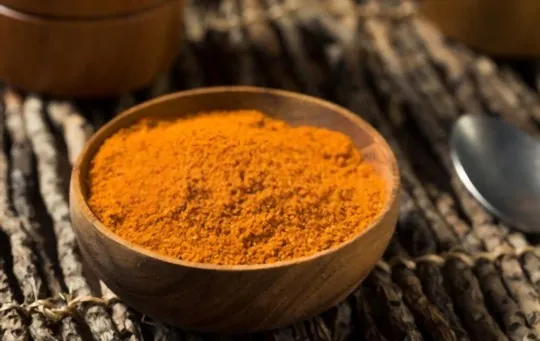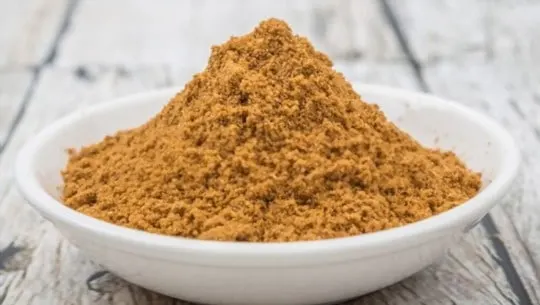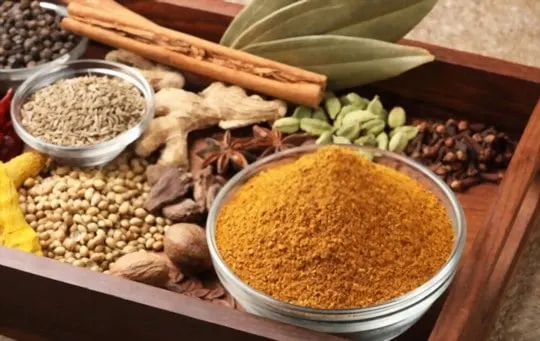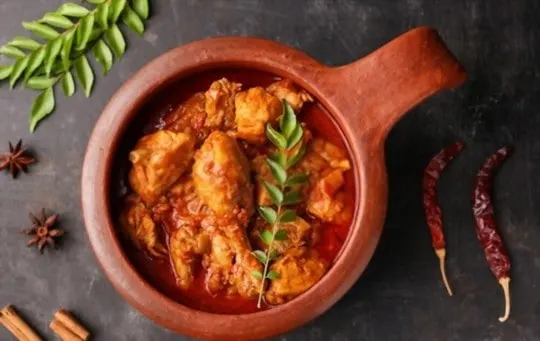Ever found yourselves in the spice aisle, scratching your heads over tandoori masala and garam masala?
Well, we’ve been there.
These mixes are the heartbeats of many dishes. What sets them apart isn’t just their ingredients. It’s like choosing between superheroes.
One brings a punchy warmth, the other smoky undertones. I remember the first time we tried cooking with each. The kitchen smelled like a spice market!
We learned a lot through trial and error. Now, we’re here to share those secrets.
Choosing the right masala can elevate your dish from meh to wow. Ready to find out which masala reigns supreme for us?

What is Tandoori Masala?

Tandoori Masala is a spice blend originating from the Indian subcontinent, commonly used in the preparation of tandoor cooked dishes.
The term ‘tandoori’ refers to the traditional clay oven called a tandoor.
This masala is a mixture of various spices blended with yogurt and lemon juice that typically includes cumin, coriander, garlic powder, ginger powder, paprika, turmeric and chili powder.
The spices are combined in specific proportions to create a distinct flavor and aroma that adds zest to any dish.
While Tandoori Masala is popularly used for dishes prepared in tandoors such as chicken tikka or tandoori cauliflower, it can also be used to enhance the flavor of vegetables, paneer or grilled meats.
The tangy taste of lemon juice and yogurt balances the heat of the spices while infusing an appetizing texture.
What is Garam Masala?

Garam Masala is a blend of ground spices, commonly used in Indian cuisine.
This spice mix typically includes cinnamon, cloves, peppercorns, cumin seeds, and cardamom seeds.
Garam Masala adds warmth and depth of flavor to dishes and is often used as a finishing sprinkle or added towards the end of cooking to enhance the aroma and taste.
- Garam Masala is a staple spice mix in Indian cooking.
- It includes cinnamon, cloves, peppercorns, cumin seeds, and cardamom seeds.
- Garam Masala adds warmth and depth of flavor to dishes.
- It is often added towards the end of cooking to enhance the aroma and taste.
Garam Masala differs from other spice blends like Tandoori Masala which are specific to certain dishes or regions.
While Garam Masala can be used in a variety of recipes, Tandoori Masala is specifically for marinating meat for the popular Tandoori Chicken dish.
Additionally, Garam Masala has a warming effect on the body while Tandoori Masala is known for its smoky flavor due to being roasted over hot flames.
Understanding the Differences Between Tandoori Masala and Garam Masala

Tandoori Masala and Garam Masala are two popular spice blends in Indian cuisine.
Both have unique flavors, making them distinct from each other.
Tandoori Masala is typically used to marinate meat before grilling in tandoor ovens, while Garam Masala is a finishing spice blend used at the end of the cooking process.
Although they may seem interchangeable, understanding the differences between these two masalas can elevate your cooking to new heights.
Tandoori Masala combines spices like cumin, coriander, turmeric, and red chili powder with yogurt to create a tangy and spicy blend.
It gives chicken or other meats a smoky flavor due to it being traditionally cooked in a tandoor oven.
On the other hand, Garam Masala provides a warm but not overly spicy taste to dishes such as curries or baked goods.
Its ingredients include cinnamon, cardamom, cloves, and black pepper.
When deciding which masala to use in your dish, consider their individual flavors and usage.
Tandoori Masala adds heat and tang while providing smokiness to dishes prepared on high heat such as grilling or barbecuing; whereas Garam Masala’s sweet subtly can be added at any point in the recipe for warmth; making it versatile and widely used as an all-purpose spice blend in Indian cuisine.
To sum up, by recognizing the differences between Tandoori Masala and Garam Masala – including the unique combination of spices that make them distinct – you’ll have more flexibility when preparing your meals with authenticity and familiarity of true subcontinental flavor profiles.
Ingredients Used
The spices used in Tandoori masala and Garam masala determine their unique flavours.
Tandoori masala primarily consists of cumin, coriander, garlic, ginger and red chili powder while Garam masala is made up of black peppercorns, cinnamon, cloves and cardamom.
The choice between the two depends on personal preference and the dish being cooked.
Some recipes call for both to be used together.
It’s important to note that Tandoori masala is typically used as a marinade for meats while Garam masala is added towards the end of the cooking process to enhance flavours.
Flavor and Aroma
The unique blend of spices in Tandoori masala results in a smoky, slightly sweet and tangy flavor that characterizes the dish.
On the other hand, Garam masala offers a warm, intense aroma that can accentuate any meal with its rich and complex essence.
Both spice blends offer a distinct taste and aroma that can transform any dish into a flavorful experience.
When it comes to choosing between Tandoori masala and Garam masala, it all depends on personal preference and the type of cuisine that is being prepared.
While Tandoori masala is commonly used for Indian barbeques or tandoor-cooked meats, Garam masala finds application in curries, stews and soups.
It’s important to note that these spices should be added sparingly to enhance the flavors rather than overwhelm them.
Spice Level and Heat
The flavor profile of Tandoori Masala and Garam Masala depends on their spice level and heat.
Tandoori Masala comprises spices like cumin, coriander, turmeric, ginger and garlic along with an intense heat from red chili powder or Kashmiri chili.
On the other hand, Garam Masala includes warm spices such as cinnamon, cardamom, cloves, black pepper and nutmeg which adds a mild heat to the dish.
Both these spice blends are widely used in Indian cuisine to enhance the taste of curries and other dishes.
However, it comes down to personal preference as to which one is a better option for you.
Culinary Applications
This article compares the culinary applications of Tandoori Masala and Garam Masala.
Tandoori Masala is typically used as a marinade for meats, poultry and fish, while Garam Masala is used as a seasoning agent in Indian cuisine.
Both masalas have a unique blend of spices that add depth and flavor to dishes.
However, Tandoori Masala has a bright red color due to the addition of red food coloring, while Garam Masala has a more subdued brown color.
The choice between the two ultimately depends on the specific dish being prepared and personal preference.
Similarities Between Tandoori Masala and Garam Masala
Tandoori Masala and Garam Masala, both are spices used in Indian cuisine to add flavor and aroma.
These spices have multiple similarities, including the blend of various spices like cumin, coriander, cinnamon, cardamom, cloves, and black pepper.
Moreover, both masalas provide warmth to dishes and are used extensively to make curries.
Additionally, these masalas are usually added towards the end of the cooking process to enhance the dish’s flavors effectively.
Another similarity is that both are readily available in supermarkets and spice stores worldwide.
Despite their similarities, both masalas can be incorporated with each other to enhance flavor and aroma in dishes.
Tandoori Masala and Garam Masala have differences as well that set them apart from each other.
Tandoori Masala has a more pungent flavor because of its use of dried red chilies, which gives it a unique smoky taste.
On the other hand, Garam Masala contains less heat than Tandoori Masala because it does not use any red chilies but is still spicy in taste due to black and white pepper usage.
How to Use Tandoori Masala and Garam Masala in Cooking?

When it comes to Indian cuisine, using the right mix of spices is crucial in creating a delicious dish.
Two popular spice blends used in cooking are Tandoori Masala and Garam Masala.
Wondering how to use them effectively? Here’s a guide on incorporating these spice mixes into your dishes.
- Tandoori Masala: This blend is primarily used for marinating meats, especially tandoori chicken. It gives the meat a vibrant red color and smoky flavor. To use, mix the masala with yogurt and marinate the meat for at least 2-3 hours before grilling or baking.
- Garam Masala: A versatile blend that can be used in both sweet and savory dishes, garam masala is made from warming spices like cinnamon, cardamom, and cloves. It is typically added towards the end of cooking to enhance the flavors of stews, curries, and even rice pilafs.
- Experiment with different combinations: While Tandoori and Garam Masalas are popular on their own, you can always experiment with different spice blends to create unique flavors in your dishes.
- Balancing flavors: Remember that adding too much of any spice blend can overpower other flavors in your dishes. Start with small amounts and adjust as per your taste preferences.
- Storage: Store both Tandoori and Garam Masalas in air-tight containers away from sunlight to maintain their freshness.
- Use high-quality spices: Using fresh, high-quality spices will ensure that you get maximum flavor out of these spice blends.
Incorporating Tandoori and Garam Masalas into your cooking can make your Indian dishes more authentic and flavorful.
So go ahead and add these spice blends to your pantry.
Considerations When Choosing Between Tandoori Masala and Garam Masala
When deciding which seasoning to use for your recipe, it’s important to consider the key differences between Tandoori Masala and Garam Masala.
These two Indian spice blends have their distinct flavors and are used in different dishes.
Tandoori Masala is intended for marinating meat, while Garam Masala is primarily used as a finishing spice.
When choosing between these two seasonings, it’s essential to know the dish you’re making and what flavor profile you’re looking for.
Keep in mind that Tandoori Masala has a smokier flavor due to its addition of paprika compared to the sweet and aromatic blend of Garam Masala’s cinnamon and cardamom notes.
Ultimately, it all comes down to personal taste preference and recipe requirements.
So, experiment with both spices to determine which one elevates your meals’ flavor best.
Conclusion
After comparing Tandoori Masala and Garam Masala, it can be concluded that both have distinct flavors and are used to enhance different types of dishes.
Tandoori Masala is best suited for marination of meats, whereas Garam Masala is used in curries and stews.
It is essential to understand the recipe’s requirements before choosing which masala to use.
Tandoori Masala works well with barbecued or grilled meat dishes.
In contrast, Garam Masala is perfect for curries containing vegetables like potatoes and carrots.

Leave a comment